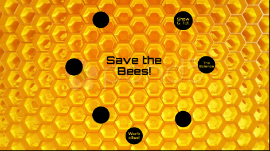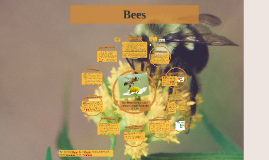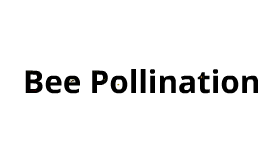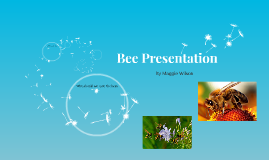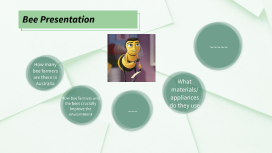Bee Presentation
Transcript: "The Importance of Bees in Nature." Food And Agriculture Organization. Web. 12 Nov. 2014. <ftp://ftp.fao.org/docrep/fao/012/i0842e/i0842e04.pdf>. "The Importance of Bees in Nature." Food And Agriculture Organization. Web. 12 Nov. 2014. <ftp://ftp.fao.org/docrep/fao/012/i0842e/i0842e04.pdf>. "EPA Pollinator Protection." Actions to Protect Pollinators. EPA, n.d. Web. 11 Nov. 2014. "National Pollinator Strategy: For Bees and Other Pollinators in England." - Publications. N.p., n.d. Web. 12 Nov. 2014. "Report on Honey Bee Health." USDA.Gov. US Department of Agriculture, n.d. Web. 12 Nov. 2014. Ellis, Jamie. "Colony Collapse Disorder (CCD) in Honey Bees1." EDIS New Publications RSS. Entomology and Nematology Department,, 1 May 2007. Web. 12 Nov. 2014. <http://edis.ifas.ufl.edu/in720>. http://media-2.web.britannica.com/eb-media/28/91428-004-B47AA1F1.jpg http://honey.joyfusions.com/wp-content/uploads/2011/09/Cross-Pollination.jpg http://www.newmediawarrior.net/wp-content/uploads/2014/02/Bee-Death-GMOs25mar08c.gif v In the wild, bees are key contributors to biodiversity. they strengthen forests and can help keep a forest healthy by pollinating new plants and trees when needed. After a forest fire or other aspect that would bring an area back in succession, bees can help bring back the vegetation in that area faster by pollinating, than natural pollination would. In many areas, bees have been seen to protect new tree sapling from getting eaten by deer and other animals. Since they are such good pollinators, they provide other food sources for many different species so they don't have to eat the saplings. Honeybees have always been biological indicators, in other words, honeybee health helps us see the general health of the environment. A reduction in honeybees could surprisngly be positive because as stated before they are not native to North America and the native species could thrive because of this. Bees are vital to nature for their pollination rituals; it is estimated that one third of the human food supply depends on insect pollination, most of which is accomplished by bees. Bees either focus on gathering nectar or on gathering pollen depending on demand. Honeybees are not native to the U.S. and were brought here from Europe by the early settlers. Bees can collect up to 66 Ibs. of pollen per year per hive.This accounts for 80% of insect pollination. Over the last year one third of the world's bee population has disappeared. Over the next twenty years scientists speculate that bees will disappear altogether. This disappearance began in the United States and quickly made its way to Europe, Latin America, and Asia. Concern is rightly placed on their disappearance: scientists conclude that along with their disappearance pollination will cease to occur; resulting in the disappearance of plants and possibly threatening mankind. A large array of government officials met in October 2012 to outline the future US policy on bees. Pathogens have detrimental effects on bees, and we must do more research on how they contract disease and how to stop them. The EPA is using regulatory actions to protect them. creating warning labels on pesticides about when not to use them to avoid damaging bees. Working in joint agency projects to make the environment more suitable for bees. researching the issues the bees are facing and publishing online how dangerous the different pesticides are to try to be able to find a way to combat these problems. Without bees, life on earth would be much different and conditions for the development of humans may not have existed. Bees are pollinators that are important to our food chain. A third of all food we eat today would not be around without the help of bees. The importance of these native pollinators in the reproduction of flowering plants is just beginning to be understood. The flowers of different plant species often require different behavior by collecting bees. Importance of Bees Effects on Industry and Consumers The 3 Castes: Bibliography By: Madison Kazar, Ryan Pearce, Andrew McDonald, James Nicolucci, Anthony Schiano Counterpoints on the issue There are three castes of honey bees: The Queen: One queen in each hive which produces all eggs. The queen bee can live between 3-5 years and lays up to 2000 eggs per day. The Queen can lay up to 250,000 eggs per year and possibly more than a million in her lifetime. The second major function of a queen is producing pheromones that serve as a social “glue” unifying and helping to give individual identity to a bee colony. Workers: All workers are female but cannot reproduce. Nearly all bees in the hive are workers and get their name because they literally "work themselves to death". During the Winter months, workers live between 4-9 months and during the Summer only about 6 weeks. Interestingly, specific chores are assigned in sequential order consiting of construction workers, guards, nursemaids, and foragers to name a few. Drones: Their sole






